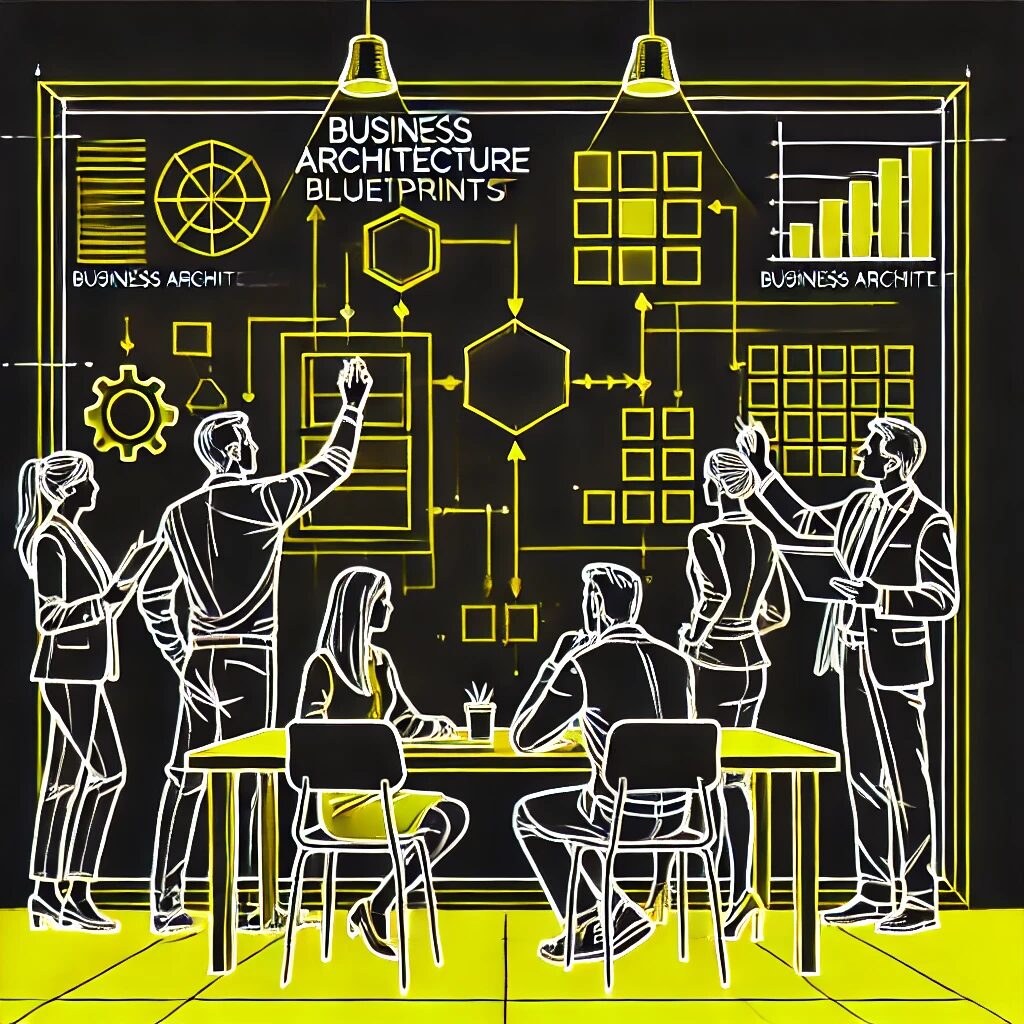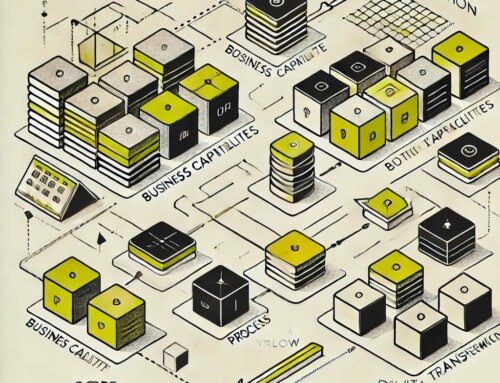
Business Architecture as the Engine of Utility Transformation. Powering Change in an Era of Industry Disruption.
The utilities sector stands at a critical inflection point. Faced with renewable energy mandates, sustainability goals, aging infrastructure, and evolving customer expectations, utility companies must transform their operations while maintaining reliability and affordability. This transformation isn’t merely technological—it requires a fundamental reimagining of business models, processes, and organizational structures.
Business Architecture serves as the essential framework connecting strategic vision to operational reality. By creating a coherent blueprint that aligns capabilities, processes, information, and technology with business strategy, utilities can navigate complex transformation journeys with greater confidence and success.
1: The Utility Transformation Imperative
The utilities sector faces unprecedented pressure to evolve. Successful transformation requires more than technology—it demands a comprehensive business architecture approach to ensure all changes align with strategic goals.
- Regulatory Evolution: Utilities must adapt to increasingly complex regulatory frameworks that mandate renewable integration, emissions reductions, and grid modernization efforts.
- Customer Expectations: Today’s utility customers demand personalized experiences, transparency, usage insights, and seamless digital interactions similar to what they receive from other service providers.
- Emerging Competitors: New market entrants from distributed energy resources to community solar programs are challenging traditional utility business models and value propositions.
- Infrastructure Modernization: Aging infrastructure requires massive capital investment while integrating smart technologies, distributed resources, and resilience measures.
- Workforce Transformation: Utilities face significant workforce challenges from retirement waves to acquiring new digital skills needed for future operations.
2: Business Architecture: The Transformation Foundation
Business architecture creates the vital connection between strategic vision and operational execution. This structured approach helps utilities define, visualize, and align their organization’s fundamental business elements.
- Strategic Alignment: Business architecture establishes clear traceability from enterprise strategy to the capabilities, processes, and systems that enable it.
- Common Language: A comprehensive business architecture creates a shared vocabulary and conceptual framework that bridges communication gaps between business and technology teams.
- Transformation Roadmap: The business architecture provides the foundation for creating logical, sequenced roadmaps that guide transformation initiatives over multiple years.
- Investment Prioritization: By mapping capabilities to strategic objectives, business architecture helps utilities prioritize investments for maximum business impact.
- Change Management: Business architecture enables utilities to anticipate and manage organizational impacts, creating more effective change management programs.
3: The Essential Components of Utility Business Architecture
A comprehensive business architecture framework for utilities integrates several key dimensions that collectively define how the organization delivers value.
- Capability Mapping: Well-defined business capabilities establish what the utility does (or should do) to fulfill its mission, independent of how these functions are organized or performed.
- Value Streams: End-to-end value streams document how the utility creates value for customers and stakeholders through sequences of activities.
- Information Architecture: The information architecture defines the critical data assets, their relationships, and governance models required across the enterprise.
- Process Architecture: Process architecture documents the key operational processes that execute business capabilities and how they interact across organizational boundaries.
- Organizational Model: The organizational architecture defines the structural, governance, and decision-making frameworks required to execute the business strategy.
4: Capability-Based Planning for Utilities
Capability-based planning shifts focus from projects to the critical business capabilities utilities need to develop or enhance to achieve strategic goals.
- Capability Assessment: Systematic assessment of current capability maturity against future requirements identifies critical gaps requiring investment or transformation.
- Strategic Alignment: Capability planning creates direct linkage between strategic objectives and the operational abilities needed to achieve them.
- Investment Optimization: Capability-based portfolios allow utilities to manage investments across organizational silos, reducing duplication and increasing strategic impact.
- Technology Rationalization: Capability mapping to applications and technologies helps utilities identify redundancies, gaps, and modernization opportunities.
- Vendor Management: Capability frameworks improve vendor selection and management by clarifying which capabilities should be developed internally versus sourced externally.
Did You Know:
- Utilities that maintain dedicated business architecture teams report 34% higher success rates in major transformation initiatives and 27% greater stakeholder satisfaction with transformation outcomes, according to a 2024 industry benchmark study.
5: Value Stream Mapping for Customer-Centric Transformation
Value stream mapping helps utilities visualize and optimize end-to-end processes from the customer perspective, breaking down traditional silos.
- Customer Journey Integration: Value streams connected to customer journeys ensure transformation efforts prioritize moments that matter most to customers.
- Cross-Functional Visibility: End-to-end value stream mapping illuminates interdependencies between departments that often operate in silos.
- Operational Bottlenecks: Value stream analysis identifies friction points, delays, and inefficiencies that impact customer experience and operational costs.
- Digital Opportunity Mapping: Value streams help pinpoint high-impact opportunities for digitalization, automation, and process improvement.
- Measurement Framework: Well-designed value streams incorporate key performance indicators that track both operational efficiency and customer value creation.
6: Information Architecture for Data-Driven Utilities
Information architecture establishes how utilities organize, govern, and leverage their most valuable asset—data—to drive better decisions and enable new capabilities.
- Data Strategy Alignment: Information architecture translates enterprise data strategy into concrete models, standards, and governance structures.
- Master Data Management: Utilities require robust MDM frameworks to maintain consistent, accurate data about critical entities like customers, assets, and meters.
- Data Governance: Clear data ownership, quality standards, and lifecycle management ensure information can be trusted for critical decision-making.
- Analytics Enablement: Well-structured information architecture creates the foundation for advanced analytics, from descriptive reporting to predictive and prescriptive capabilities.
- Integration Architecture: Information architecture defines how data flows between operational systems, enterprise applications, and external partners or customers.
7: Organizational Architecture for Agile Utilities
Organizational architecture defines how utilities structure themselves to deliver capabilities, make decisions, and adapt to changing conditions.
- Decision Rights Framework: Clear governance models establish who makes which decisions and how they are made across the enterprise.
- Role Definition: Organizational architecture defines key roles, responsibilities, and skills required to execute core capabilities and strategic initiatives.
- Matrix Management: Many utilities benefit from matrix organizational models that balance functional expertise with cross-functional delivery teams.
- Communities of Practice: Organizational architecture can establish formal and informal networks that share knowledge and drive innovation across organizational boundaries.
- Change Capacity: Mature organizational architecture includes mechanisms to gauge and develop the organization’s capacity to absorb and implement change.
8: Technology Architecture Aligned to Business Needs
Technology architecture becomes more effective when guided by business architecture, ensuring IT investments deliver maximum business value.
- Business-Driven Requirements: Business capabilities and value streams generate more meaningful technology requirements than traditional project-based approaches.
- Application Rationalization: Mapping applications to business capabilities helps identify redundancies, gaps, and modernization priorities.
- Integration Strategy: Business architecture informs integration priorities by highlighting critical information flows between capabilities and processes.
- Technology Standards: Business architecture helps establish technology standards that enable reuse, interoperability, and consistent customer experiences.
- Cloud Migration Planning: Business architecture provides the context for determining which workloads should move to cloud environments and in what sequence.
9: Grid Modernization Through Business Architecture
Grid modernization programs benefit significantly from business architecture approaches that connect physical infrastructure to business capabilities and customer value.
- Capability Prioritization: Business architecture helps utilities prioritize grid modernization capabilities based on strategic objectives, rather than technology-driven approaches.
- Cross-Functional Integration: Grid modernization requires tight integration between traditionally siloed functions, which business architecture helps orchestrate.
- Benefit Realization: Business architecture creates frameworks for tracking and realizing benefits from grid investments across operational, customer, and financial dimensions.
- Vendor Ecosystem Management: As grid modernization involves multiple technology partners, business architecture provides a framework for managing these complex relationships.
- Regulatory Alignment: Business architecture helps align grid modernization investments with regulatory requirements and demonstrating their value to regulators.
Did You Know:
- According to a 2023 utility industry survey, organizations with mature business architecture practices are 2.7 times more likely to achieve their transformation goals on time and within budget than those without formalized business architecture.
10: Customer Experience Transformation
Business architecture approaches help utilities reimagine customer experiences by connecting customer journeys to internal capabilities and processes.
- Journey Mapping Integration: Business architecture connects customer journey maps to the capabilities, processes, and systems that deliver each customer touchpoint.
- Omnichannel Strategy: Business architecture helps utilities develop consistent experiences across channels by defining common capabilities and information requirements.
- Digital Experience Roadmap: By mapping digital capabilities to customer value, business architecture creates more effective digital transformation roadmaps.
- Self-Service Enablement: Business architecture identifies the capabilities, information, and integrations required to enable robust self-service options.
- Voice of Customer Integration: Business architecture helps integrate customer feedback mechanisms into ongoing capability development and process improvement.
11: Sustainable Energy Transition Planning
Business architecture provides frameworks for planning and executing the transition to sustainable energy models and operations.
- Capability Gap Analysis: Business architecture identifies new capabilities utilities must develop to support renewable integration, electrification, and carbon reduction.
- Operating Model Evolution: As utilities transition from centralized to distributed models, business architecture guides operating model changes required.
- Partnership Ecosystems: Business architecture helps utilities define how they will engage with partners in new energy services, electric vehicle infrastructure, and other emerging areas.
- Regulatory Navigation: Business architecture helps utilities articulate sustainable energy transition plans to regulators and stakeholders in coherent, defensible ways.
- Investment Sequencing: Business architecture enables utilities to sequence sustainable energy investments logically while maintaining operational reliability.
12: Enterprise Risk and Resilience Management
Business architecture strengthens utility risk management by connecting enterprise risks to the capabilities, processes, and technologies they affect.
- Risk-Capability Mapping: Business architecture allows utilities to map enterprise risks to the specific capabilities they impact, creating more targeted mitigation strategies.
- Resilience Planning: By identifying critical capabilities and their dependencies, business architecture enhances resilience planning for both physical and cyber threats.
- Regulatory Compliance: Business architecture helps utilities translate regulatory requirements into specific capability, process, and control changes.
- Third-Party Risk Management: Business architecture clarifies which capabilities rely on external partners, improving vendor risk assessment and management.
- Business Continuity: Business architecture identifies critical capabilities requiring robust continuity plans and helps prioritize recovery efforts.
13: Business Architecture Governance and Sustainability
Establishing effective governance ensures business architecture remains relevant and valuable throughout the transformation journey.
- Architecture Review Board: A cross-functional review board ensures business architecture remains aligned with strategic priorities and drives consistent implementation.
- Standards and Methodologies: Clear standards and methodologies ensure business architecture deliverables maintain consistent quality and usability across the enterprise.
- Architect Development: Formal career paths and skill development programs build business architecture capabilities within the utility workforce.
- Tool Strategy: An effective tool strategy ensures business architecture artifacts are accessible, maintainable, and integrated with other enterprise processes.
- Measurement Framework: Regular assessment of business architecture maturity and value delivery keeps the practice aligned with enterprise needs.
14: Implementation Roadmap for Business Architecture
A phased approach to implementing business architecture increases adoption and demonstrates value throughout the journey.
- Current State Assessment: Begin with an honest evaluation of existing business architecture maturity, identifying strengths to leverage and gaps to address.
- Strategic Alignment: Ensure business architecture efforts connect directly to strategic priorities and transformation initiatives with executive visibility.
- Quick Win Identification: Identify opportunities to demonstrate business architecture value through focused efforts with visible business impact.
- Capability Building: Develop both the business architecture artifacts and the organizational capabilities needed to create and use them effectively.
- Continuous Improvement: Establish feedback loops to regularly refine business architecture approaches based on stakeholder needs and transformation outcomes.
Did You Know:
- A 2024 study by the American Public Power Association found that utilities with documented business capability models could reduce their technology modernization costs by an average of 23% through improved application rationalization and reuse.
Takeaway
Business Architecture provides the essential foundation for successful utility transformation by creating a coherent blueprint that connects strategy to execution. By establishing clear capability models, value streams, and information frameworks, utilities can navigate complex changes with greater confidence and success. The business architecture approach ensures technology investments align with business priorities, customer experiences improve across channels, and new operating models emerge to support sustainability objectives. Most importantly, business architecture helps utilities maintain operational excellence throughout their transformation journey by providing a stable framework for evolution rather than disruption.
Next Steps
- Assess Your Current State: Conduct an honest assessment of your utility’s business architecture maturity, identifying existing artifacts that can be leveraged and critical gaps to address.
- Start With Strategy: Connect your business architecture efforts directly to strategic priorities, ensuring executive sponsorship and business ownership from the beginning.
- Focus on Critical Capabilities: Identify and document the most strategically important business capabilities that will drive your transformation agenda.
- Map Customer Journeys: Document key customer journeys and connect them to the internal capabilities and processes that deliver them.
- Build Cross-Functional Teams: Establish a business architecture community with representation from across the organization to drive collaboration and adoption.
- Implement Governance: Create lightweight but effective governance to ensure business architecture remains relevant and valuable throughout your transformation journey.



